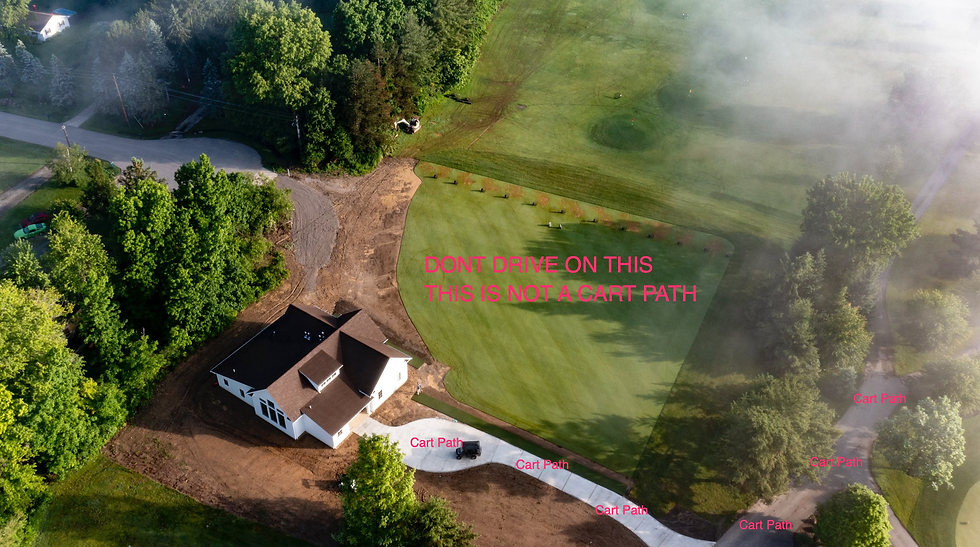Just Don't #2 - The Range
- mattv4
- Jun 10, 2022
- 3 min read
Welcome to the second addition of Just Don't. It's our ongoing gentle diatribe of stuff that perhaps should not need to be said. We will say it anyway.
You Sure Love You Some Range Ball
The new range opened up last Friday, June 3rd. In 6 days you all have hit over 92,000 golf balls.
OK, that's a lie. . I have no idea how many balls were hit. But, it sure looks like it! Check out this agricultural delight*. 6 days!

Let's focus a little closer, shall we? Take a look at this fine example:

The problem with the above concentrated divot pattern (yes, this is on our range) is the range does not heal and it is more time consuming to maintain. More time maintaining the range = less time maintaining the golf course. I pulled a small child out of that hole before taking the photo (he was safely returned to his home).
Don't, Don't and Do
Don't Make A Concentrated Divot Pattern
Per the USGA
A concentrated divot pattern removes all turf in a given area. While this approach does not necessarily result in a full-sized divot removed with every swing, by creating a large void in the turf canopy there is little opportunity for timely turf recovery.
Don't Make A Scattered Divot Pattern
Per the USGA
A scattered divot pattern removes the most amount of turf because a full divot is removed with every swing. Scattering divots results in the most turf loss and uses up the largest area of a tee stall. This forces the golf facility to rotate tee stalls most frequently and often results in an inefficient use of the tee.
DO Make A Linear Divot Pattern
The linear divot pattern involves placing each shot directly behind the previous divot. In so doing, a linear pattern is created and only a small amount of turf is removed with each swing. This can usually be done for 15 to 20 shots before moving sideways to create a new line of divots. So long as a minimum of 4 inches of live turf is preserved between strips of divots, the turf will recover quickly. Because this divot pattern removes the least amount of turf and promotes quick recovery, it is the preferred method.
TOO MUCH - GET TO IT!
Yeah, that was too many words. Simply, this is about letting the range heal quickly. Let's go with a pretty picture instead.

Just do this linear thing! ^^^^
For those of you who think I am making this up, let the authority, Golf Digest, speak.
"Just Don't" Bonus Round
I can't believe we are saying this. Here goes. . .
You can not take your cart on the range.**
Golf carts remain on cart paths surrounding the range at all times.

*photo - Tim Naujoks
Golf Etiquette Tip Of The Week
We got a suggestion or two that we sprinkle these in. Let's do this.
Slower Groups Play Through
I blatantly scraped this off the information superhighway:
There’s no specific rule in golf stating you must let faster groups play through on the golf course, but it’s accepted etiquette that makes sense. If your group is travelling around the course slowly and another group appears behind, you should let them pass (or at least offer to do so.)
My take on it:
Just ask the group if they want through. Everyone has more fun.
If you play a 2some with ten 4somes in front of you, settle in. There's no place for you to go.
More light paraphrasing:
How to Proceed
Playing through most typically occurs in one of these ways:
The Slow Group is on the green while the Fast Group waits in the fairway. Slow Group waves Fast Group up to the green. After Fast Group plays approach shots, Slow Group putts out. Slow Group waits on next tee and allows Fast Group to tee off first, moving them ahead.
The Fast Group reaches tee box while Slow Group is still teeing off. Slow Group allows Fast Group to tee off and move ahead.
If the hole ahead of the Slow Group is occupied by another group, then the Fast Group will just have to deal with waiting because there is nowhere to play through to.
*Many a thank you to Tim Naujoks for the drone photo of the range. Incredibly talented and incredibly local. Check him out please (especially since he did not charge me for the awesome photos).
**If you are flying a blue flag on your golf cart, driving on the range is just peachy.







Comments